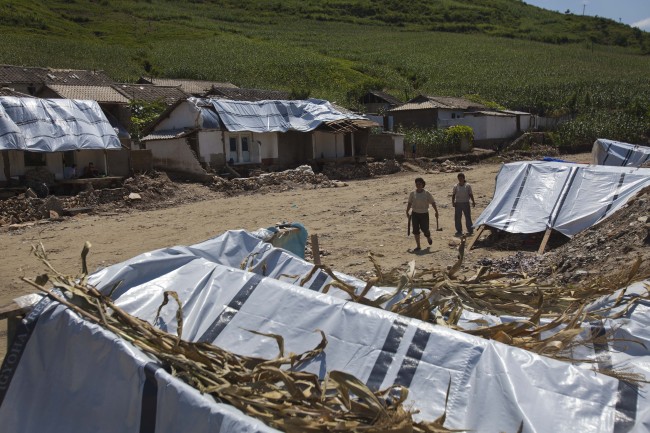N. Koreans recount terror when flood engulfed hamlet
By Korea HeraldPublished : Aug. 15, 2012 - 20:09
UNGOK, North Korea (AP) ― Tears rolled down Ri Hyang Ran’s cheeks as she recalled her terror the night floods engulfed her farming-and-mining hamlet northeast of North Korea’s capital, Pyongyang.
As the rain pounded down, town officials went door to door hustling residents out of their homes in the middle of the night. Still in her pajamas, Ri said she only had time to grab two things: her portraits of North Korea’s late leaders Kim Il Sung and Kim Jong Il.
Huddling with her neighbors in the mountains high above the village, she could see nothing in the darkness but the sheets of rain that pummeled Songchon county on the night of July 23.
“But I could hear the sound of walls collapsing, and it was terrifying,’’ she told The Associated Press on Monday, wiping her tears away with a towel. When dawn broke, she discovered that her home for the past two decades was gone, swept away by the torrent of water that tore through this part of South Phyongan province.
The threat of floods is nothing new to the area, a valley where the waters from four regions converge. But this year’s rains were the worst in recent memory, villagers said Monday, many standing on the rocky dirt where their homes once stood.
As the rain pounded down, town officials went door to door hustling residents out of their homes in the middle of the night. Still in her pajamas, Ri said she only had time to grab two things: her portraits of North Korea’s late leaders Kim Il Sung and Kim Jong Il.
Huddling with her neighbors in the mountains high above the village, she could see nothing in the darkness but the sheets of rain that pummeled Songchon county on the night of July 23.
“But I could hear the sound of walls collapsing, and it was terrifying,’’ she told The Associated Press on Monday, wiping her tears away with a towel. When dawn broke, she discovered that her home for the past two decades was gone, swept away by the torrent of water that tore through this part of South Phyongan province.
The threat of floods is nothing new to the area, a valley where the waters from four regions converge. But this year’s rains were the worst in recent memory, villagers said Monday, many standing on the rocky dirt where their homes once stood.

The floods not only killed at least 169 North Koreans nationwide and destroyed tens of thousands of homes, according to official accounts, but also left huge swaths of farmland submerged in water. Across the county, corn, rice and soybean plants already damaged from a protracted drought in May and June lay withered and stunted just a month before harvesting season is set to begin.
Mountainous North Korea already struggles to feed its people. A U.N. report in June said some two-thirds of the country’s 24 million people are coping with food shortages, with hunger dire in some areas. Emergency food aid shipments started last week, the World Food Program said.
The prospect of flooding strikes fear in North Koreans, who well remember when heavy rains in the mid-1990s triggered deadly landslides. An ensuing famine killed hundreds of thousands of people, according to economist Marcus Noland, during a period North Koreans call “the Arduous March.’’
New leader Kim Jong Un addressed land management in the first official treatise issued after he took power following the death of his father Kim Jong Il in December, calling for officials to shore up rivers and reforest mountains denuded of trees in decades past.
Along the rutted roads to Songchon county, soldiers and workers were carrying boulders, sometimes one by one, to rebuild levees damaged by the floods and repair collapsed roadways that have left villages such as Ungok District cut off from the relief and repair work. The AP was among several foreign media organizations taken by the North’s Red Cross Society to the village on a requested reporting trip Monday. The journalists were not escorted by government minders.
Ri, who lost her home in Ungok District, said she stayed with neighbors until the Red Cross came last week with emergency supplies: blankets, a hand mirror, a camping kitchen set, medicine, a water jug and a tarp that she draped over a rustic wooden frame made of branches. The box that the goods came in served as a dresser; her husband’s clothes hung on a clothesline outside.
“As long as they can reopen the roads and bring in cement, we can start rebuilding ― and my home really was grand,’’ she said, dissolving into tears. She said she wishes she had saved family photos and the medals her sons won during their military service.
North Koreans are taught from childhood to revere the Kim family, and portraits of the two late leaders are prominent in every home. It is not unusual for them to be protected with more care than family photos.
Ri said she had only a split second to leave and grabbed the portraits off the wall as she fled. She said they are being stored at her husband’s workplace for safekeeping.
-
Articles by Korea Herald




![[Herald Interview] 'Amid aging population, Korea to invite more young professionals from overseas'](http://res.heraldm.com/phpwas/restmb_idxmake.php?idx=644&simg=/content/image/2024/04/24/20240424050844_0.jpg&u=20240424200058)













![[KH Explains] Korean shipbuilding stocks rally: Real growth or bubble?](http://res.heraldm.com/phpwas/restmb_idxmake.php?idx=652&simg=/content/image/2024/04/25/20240425050656_0.jpg&u=)

